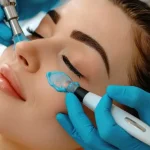
Artificial light photonot only overcomes the limitations of nature but also opens up the possibility of complete control over color spectrum, intensity and effects. This article nowgoal will explore two core aspects: the scientific foundation and the technological development ofimage, and analyzes practical applications in professional photography and contemporary visual design.
Scientific foundation of artificial light photography
Artificial lighting technology has evolved from incandescent bulbs to intelligent LED systems.Image based on the principles of electroluminescence and spectrum modulation to reproduce or create visual environments. Follow bảng xếp hạng bóng đá right away.
The principle of light emission of artificial light sources
Tungsten bulbs operate at temperatures ranging from 2800K–3200K, producing a continuous spectrum of light with strong intensity in the red region. Meanwhile, fluorescent lamps use a phosphor coating to convert UV rays into visible light, achieving a color rendering index (CRI) of 80–90, suitable for indoor lighting. These light sources laid the foundation for the development ofartificial light photoin photography and cinema.
Modern LEDs use GaN chips that emit photons at 450nm (blue) combined with a yellow phosphor layer to produce white light with a temperature range of 2700K–6500K. The PWM pulse adjustment system with a frequency of 1kHz–20kHz helps eliminate flickering when recording high-speed video at 120fps. With a luminous efficiency of 150–200 lm/W, LEDs are much superior to traditional tungsten bulbs that only reach about 15 lm/W.
Color spectrum control technology in artificial light images
Image increasingly enhanced by the remarkable progress of modern lighting technology. The RGBW system allows mixing of up to 16.7 million colors with an accuracy of Delta E < 2, while the COB lamp with integrated TIR lens provides a flexible beam angle of 15°–120° without loss of intensity. Bi-color LED can adjust the color temperature from 2700K to 6500K in just 0.5 seconds, helping to adaptfast in all lighting conditions.
HERartificial lightcQuantum dot technology increases color saturation by about 30% compared to conventional LEDs, for more vibrant and realistic colors. The DMX512-RDM system supports 512 channels of synchronous control of up to 255 devices with a delay of less than 20 ms, ensuring stability and precision in professional lighting coordination. These improvements open up a new creative space, where technique and aesthetics blend in every frame.
Practical applications of artificial light in photography
From professional studios to film projects, image andoffers outstanding flexibility in controlling and shaping light. Thanks to its ability to precisely reproduce lighting conditions, it opens up a consistent and proactive creative space for the artist.
Three-point lighting technique in studio portraits
The key light is placed at a 45° angle with a 120x80cm softbox to create natural shadows with a light-dark ratio of 1:3, giving the frame a sense of depth. The fill light uses a white reflector that reflects about 50% of the key light’s intensity to soften the shadows and reduce overall contrast. The back light is mounted at a narrow 10° angle to create a 2-3 pixel thick rim light, helping to subtly separate the subject from the background.
Artificial light photo kTwo additional kicker lights were used from a 30° angle below to highlight the chin line and create a three-dimensional look for the face. The key:fill:back ratio was maintained at 8:4:2 to achieve a cinematic effect with a balance between light and dark. CTO 1/2 color gel was used to convert tungsten light into daylight, ensuring a balanced color temperature and uniform light tone throughout the frame.
Dramatic lighting effects in product photography
Artificial light photodemonstrating precision and sophistication in controlling light sources to highlight product details. The 2000W Fresnel lamp combined with the barn door creates a spotlight area about 50cm in diameter, focusing light on the high-end watch to highlight the sophisticated lines. The metal gobo engraved with the shape of leaves creates artistic shadows on a white background, while the 1x1m light panel with 216 diffusion reduces harsh reflections by up to 80%, providing soft and even light.

Technique low-keywith a contrast ratio of 16:1 used to highlight the leather texture, creating depth and a luxurious feel. The systemwireless trigger Godox XProEnables high-speed 1/8000s sync with medium format cameras, ensuring absolute precision with every flash.
Conclude
From the first incandescent bulb to the intelligent LED system,artificial light photohas completely changed the way we perceive the visual world. While it cannot replace the raw beauty of nature, the absolute control and reproducibility ofimageremains the foundation for every professional creation. The future lies in the combination of AI-driven lighting and new luminescent materials, where each frame is not just an image but a perfectly programmed emotional experience.




